
The index page for the 1954 French flap section of this website is here.
Reference for this case: 24-Sep-54-Grenoble.
Please cite this reference in any correspondence with me regarding this case.
Mr. Jacques Baccard, presented in the press as a 34-year-old radio-electrician of Grenoble, son of an aviation observer and owner of a radio shop 2 rue du Crepu, had been interested in the "flying saucers" as early as 1949. He had gathered around him a group of technicians who shared his curiosity and founded a research group, which had merged with the investigative group organized by the pioneer of French ufology Jimmy Guieu, the International Inveswtigation Commission "Ouranos".
In 1953, Baccard and several motorists allegedly observed "a luminous disk on the road of Annecy", and thereafter his group would have seen "a huge ball of fire which maneuvered for several seconds on Mount Moucherotte". Observing the moon with his small telescope, Baccard reportedly saw a dark body crossing it, and he and his group thought it could be an artificial satellite.
Encouraged by these successes, Baccard and his friends had organized a systematic program of observation of the sky. They used powerful binoculars, a magnetic field detector designed by Baccard, and he always carried his camera ready for instant use.
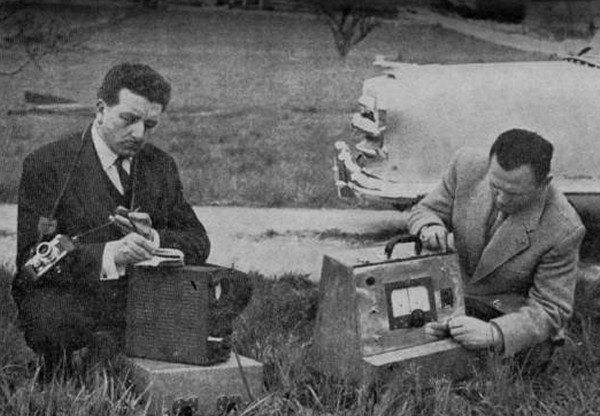
|
Above: The photo shows Jimmy Guieu on the left and Jacques Baccard on the right, testing a "magnetic detector reacting to the passage of flying saucers" designed by Baccard.
The observation that interests us here would was apparentlyreported first in the national newspaper Le Parisien Libéré for September 30, 1954. It appeared in the regional newspaper L'Est Républicain for October 1, 1954. This newspaper indicated that Baccard had noticed from his window that strange gleams rose to the sky deom some spot, several times a week.
At each of his moments of relaxation in his work, he watched these spots which intrigued him. On Sunday, September 24, 1954, at about the same time as Chambéry's inhabitants saw a flying saucer, he would have seen on the horizon "an aerial vehicle which he first took for an airplane" because the machine was like the tail of a plane seen from the front, in the center of which one could see a circular protrusion that could be the cabin. But the speed of the machine seemed excessive, he had "the impression that he was finally in the presence of a saucer."
At the moment when the machine passed vertically, it slowed down and then turned, emitting a fluorescence; by this turn, the craft showed that it had a circular shape. Baccard had his camera and took a shot that "despite the distance (about 2,000 meters)" showed a disc in the sky "followed by a luminous trail." A few seconds after the shooting, the craft reportedly rose vertically and disappeared "at a prodigious speed."
The newspaper concluded that Mr. Baccard intended to go to Paris to show his photograph, "which is very blurry, but which makes the most skeptical think."
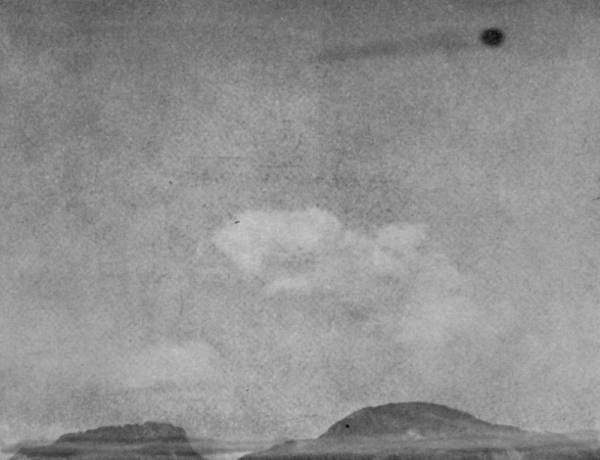
|
Above: the picture of the alleged craft.
Then the photo appeared with an article in the magazine La Semaine du Monde for November 5, 1954. This magazine stated that Chambéry "was at the hour of the digestive drinking" when the "thing" happened; "which explains the small number of witnesses." Baccard is quoted saying that it was precisely 01:10 p.m. when his attention was attracted by a silhouette appeared in the space cut in the Isere valley between the Vercors and Chartreuse mounts. He explained that he first thought it was an airplane since planes coming from the north were using this passage. Just 15 seconds later, the craft was above the suburbs of Grenoble, he then understood that this speed excluded an airplane, and also noted the absence of engine noise.
Ouranos magazine published the report by Jacques Baccard on his observation in their #12 of the 4th quarter of 1954, with the famous photo.
The report indicated that on September 24, 1954, at 01:10 p.m. in the Grenoble area, their regional correspondent Jacques Baccard, Chairman of the Study Group OURANOS of Grenoble and its Scientific Research Center, took a photo f a flying saucer. They had "noted from the angle of observation" that the craft passed over the Isere very slightly in front of Mount Rachais; at an altitude of 1,000 to 2,000 meters, that it had a diameter of about 80 meters "evaluated by comparative measurement", that its trail was about 900 meters long and was due "to the condensation of the air in ionized medium (?)."
The body of the craft was said to be "dark and ovoid", the perimeter of the craft being "fluorescent" white. Jacques Baccard's assistant allegedly followed it for a minute with a telescope 20 x 55 which "brings back to 500 meters an object seen at 10 kilometers", "the different moves of the craft." The speed of movement of the craft during its right ascent would have been "about 7 times that of a supersonic airplane."
Baccard noted that the saucer first appeared in the distance and at high altitude, on the edge, revealing an upper dome. It came from a spot on the left side of the photo and was heading to the right side. The object had grown visibly as it approached and descended. At the end of 30 seconds it had tilted and was now only an elliptical figure; its trajectory gradually recovered, until being horizontal. Ten seconds later, there was a sharp deceleration, and it was then that the visible trail seen on the photo had appeared. Then, in 3 seconds, at a blazing speed and with an increase of "fluorescence", the disc rose to the right, in a horizontal position, presenting again its upper dome, in profile, and disappeared from view, remaining only visible a few seconds to the telescope.
The photo would have been taken at 1/200 of a second.
Finally, Jimmy Guieu, founder of Ouranos, reported the case in his 1956 book "Black-Out Sur Les Soucoupes Volantes". The story is similar, but we also learn that seeing the saucer, Baccard had called his mother and his wife near him, and that he had the craft in his 20x magnifying glass for ten seconds.
He indicated that the shape of the machine which appeared to him in perspective like that of a spindle or a cigar was in fact that of a disc "becoming slightly ovoid towards the rear and having in its center a kind of spherical cabin whose two hemispheres were equally distributed on both sides of the plane of the disk, around which a luminous halo of high intensity rendered the contours imprecise. The body of the craft was of a very dark metallic gray and its periphery a fluorescent white."
It was when he saw that the flying saucer flying over Grenoble now began a turn towards the Chartreuse, that he had left his telescope and took the shot. Moments later, the craft climbed vertically, in a blazing acceleration, taking 6 to 7 seconds to disappear from their view.
[Ref. ern1:] NEWSPAPER "L'EST REPUBLICAIN":

|
(Continued from the front page)
Dr. Martinet, a dermatologist in Chambéry, regarded as a methodical, observant, and level-headed man, did not believe in the existence of flying saucers until last week. He used to shrug his shoulders every time someone spoke to him about these mysterious craft.
A former artillery observer with the rank of captain, the doctor has just been struck by an observation, the details of which he has entrusted to us in writing. He has also sent a copy of the following report, with even more detail, to the Prefecture of Savoie.
Here are the facts:
It was about 5:12 p.m. last Sunday (September 26). My family and I were returning by car from the Col du Chat, above Aix-les-Bains, when suddenly I noticed, directly above the Croix du Nivollet, at about two thousand meters altitude, at the edge of the misty zone, a dark aluminum-gray mass.
"I stopped my vehicle. Three other cars following me did the same, and we watched the maneuvers of the saucer. It was then 5:14 p.m. and 30 seconds.
"At first I thought it was a waterspout, but the wind was blowing from the northwest and the phenomenon came from the south.
"Thirty seconds later, while about fifteen of us were observing the saucer, it descended in a "falling leaf" motion and then appeared in the form of a concave plate with its raised side facing upward.
"Finally, at 5:16 p.m., as it presented itself head-on - that is, in the form of a perfect disc - we observed that the lighter part occupied the center of the whole, with darker patches all around.
"After that, the saucer moved directly above the Revard cable-car station, descended a little, then suddenly vanished like lightning.
"Depending on the angle from which we observed it, it changed color, shifting from very dark aluminum gray to a lighter gray.
"It was exactly 5:18 p.m. and 40 seconds when it disappeared.
"The phenomenon lasted a little over four minutes; which allowed me to record the different stages of its evolution in my notebook, along with the times.
The doctor made a diagram of the tortuous path followed by the saucer, which he shared with us along with his descriptions.
A distinguished electrical engineer from Grenoble, Mr. Baccard, correspondent for the "Uranos" Society - a private organization whose role is to collect testimony about flying saucers - had noticed that strange lights rose from a particular point several times a week in the sky, at the horizon visible from his windows.
The engineer carefully monitored these points, which intrigued him, during his moments of rest from work, and last Sunday, at roughly the same time that the people of Chambéry saw a flying saucer, here is what Mr. Baccard observed:
He saw on the horizon an aerial craft he first took for an airplane. Indeed, the object appeared like the tail assembly of a plane seen from the front, at the center of which one could distinguish a circular protuberance that could have been the fuselage. Alerted by the unusual speed of the craft, Mr. Baccard realized that he was most likely in the presence of a saucer.
At the moment this mysterious object passed overhead, it slowed down and then banked, emitting a glow; in this turn, the saucer (for that is what it was!) revealed its circular shape.
Mr. Baccard had at hand a precision camera; he took a photograph which, despite the distance (about 2,000 meters), shows in the sky a disc followed by a luminous trail.
A few seconds after the photograph was taken, the saucer rose vertically and disappeared at tremendous speed.
Mr. Baccard intends to go to Paris to show his photograph, which is very blurry, but which gives pause even to the most skeptical.
R.L.
[Ref. sme1:] "SEMAINE DU MONDE" MAGAZINE:
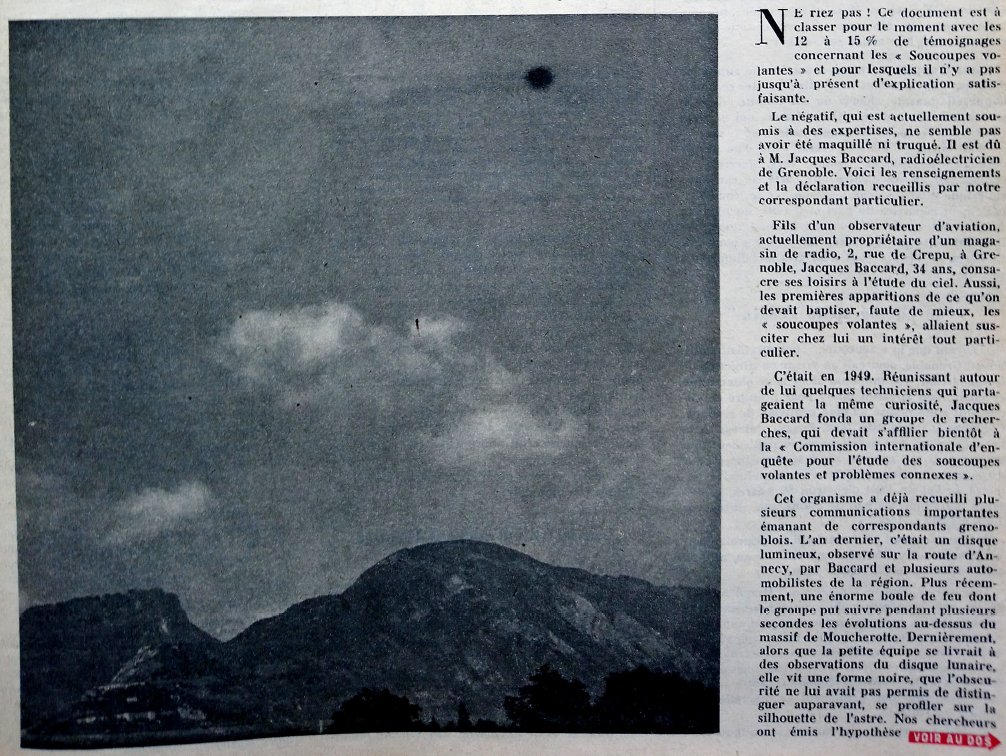
|
Do not laugh! This document is to be classified for the moment with the 12 to 15% of testimonies concerning "flying saucers" for which there is, up to now, no satisfactory explanation.
The negative, which is currently undergoing expert analysis, does not appear to have been altered or faked. It belongs to Mr. Jacques Baccard, radio technician from Grenoble. Here is the information and the statement collected by our special correspondent.
The son of an aviation observer, and currently the owner of a radio shop at 2, rue de Crepu, in Grenoble, Jacques Baccard, 34, devotes his leisure time to the study of the sky. Thus, the first appearances of what had to be called, for lack of a better term, "flying saucers," aroused a very particular interest in him.
It was in 1949. Bringing together around him a few technicians who shared the same curiosity, Jacques Baccard founded a research group, which was soon to affiliate with the "International Commission of Inquiry for the Study of Flying Saucers and Related Problems."
This organization has already collected several important reports from correspondents in Grenoble. Last year, it was a luminous disc, observed on the road to Annecy by Baccard and several motorists heading to the station. More recently, there was a red point that could be followed for several seconds above the sky over the Moucherotte massif. Lately, the Grenoble group had also noted the presence of a luminous object moving in the sky at a speed that did not correspond to any known craft at the time, silhouetted against the outline of the star. Our researchers have put forward the hypothesis
SEE OVERLEAF

|
that the craft, which was moving in the same direction as the Earth's rotation and emitted no light, could have been an artificial satellite.
Encouraged by these various observations, Baccard and his friends decided to tempt fate by multiplying systematic observations of the sky.
On Friday, September 24, Jacques Baccard was on the balcony of his villa on the road to Eybens in the suburbs of Grenoble, which he had turned into a true little observatory. Set up with his measuring boards and the two high-caliber telescopes used for the group's work, he kept within reach the camera he always had ready in such cases. Lulled by the last warmth of the fine season, the city stretched out at the observer's feet was at the hour of the after-dinner drink when the "thing" occurred, which explains the small number of witnesses.
"It was exactly 6:10 p.m.," recounts Jacques Baccard, "when my gaze was drawn to a silhouette that had just appeared in the gap formed by the Isère valley at the exit of Grenoble, between the Vercors massif and the Chartreuse. At first, I took the thing for a plane. This route is in fact the one used by aircraft coming from the north to approach the Grenoble airfield.
"Barely fifteen seconds had passed when the craft was already approaching the outskirts of Grenoble. Intrigued by this fantastic speed, as well as by the fact that the movement was accompanied by no engine noise, I aimed the smaller of my telescopes at it. At the same time, the craft, which was then above the city, made a sudden acceleration, followed by a strong burst of light similar to the glow of an electric arc. Moreover, it left behind it a light gray trail, darker along its central axis, and faintly luminous on the edges.
"Having called my mother and my wife to join me, I kept the craft in the field of my telescope (which has a magnification of twenty) for about ten seconds. Its shape, which first appeared to me in perspective as spindle-shaped - or like a cigar - was in reality that of a disc becoming slightly ovoid toward the rear and having in its center a sort of spherical fuselage whose two hemispheres were equally divided above and below the plane of the disc. Around it was a halo of intense light which made its edges indistinct. The body of the craft was a very dark metallic gray.
"Seeing that the 'saucer,' which was now flying over Grenoble, was beginning a turn toward the Chartreuse, I abandoned my observation and grabbed my camera to take this picture, which was taken at 1/500th of a second. A few moments later, the craft rose vertically, in a truly lightning-fast acceleration. It took about six to seven seconds to disappear from view. According to my calculations, the diameter of the craft was about 80 meters, its distance from me about 2 km, its altitude between 1,000 and 1,200 meters."
Jacques Baccard is categorical: it could not have been a weather balloon, a flight of birds, or any known atmospheric phenomenon.
What should we think of such a testimony? Among all the accounts that the press publishes daily, it seems to be one of those that appear to show seriousness and good faith. In fact, most of the most interesting statements never see the light of day; they are sent to scientific organizations or to newspapers like ours by correspondents who request discretion for fear of ridicule.
[Ref. ame1:] "SEMAINE DU MONDE" TRANSCRIPT BY LEX MEBANE:
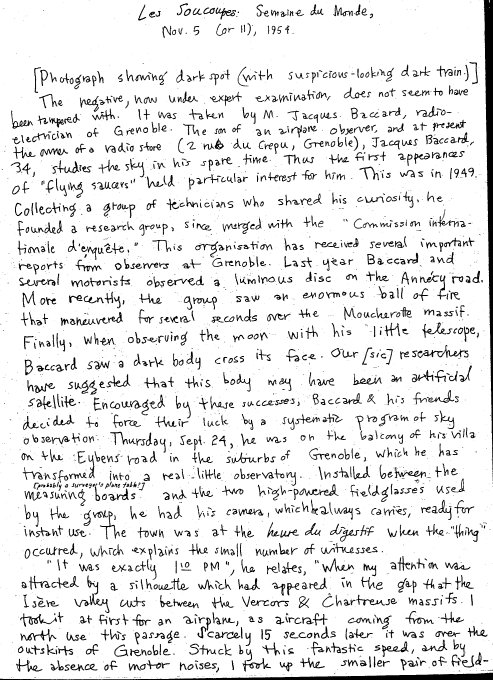
|
Les Soucoupes: Semaine du Monde
Nov. 5 (or 11), 1954
(Photograph showing dark spot (with suspicious looking dark trail))
The negative, now under expert examination, does not seem to have been tampered with. It was taken by M. Jacques Baccard, radio-electrician of Grenoble. The son of an airplane observer, and at present the owner of a radio store (2 rue du Crepu, Grenoble), Jacques Baccard, 34, studies the sky in his spare time. Thus the first appearances of "flying saucers" held particular interest for him. This was in 1949.
Collecting a group of technicians who shared his curiosity, he founded a research group, since merged into the "Commission internationale d'enquête." This organization has received several important reports from observers at Grenoble. Last year Baccard and several motorists observed a luminous disc on the Annecy road. More recently, the group saw an enormous ball of fire that maneuvered for several seconds over the Moucherotte massif. finally, when observing the moon with his little telescope, Baccard saw a dark body cross its face. Our (sic) researchers have suggested that this body may have been an articifial satellite. Encouraged by these successes, Baccard and his friends decided to force their luck by a systematic program of sky observation. Installed between the measuring boards and the two high-powered fieldglasses used by the group, he had his camera, which he always carries, ready for instant use. The town was at the heure du digestif when the "thing" occurred, which explains the small number of witnesses.
"It was exactly 1.10 PM", he relates, "when my attention was attracted by a silhouette which had appeared in the gap that the Isère valley cuts between the Vercors and Chartreuse massifs.
"I took it at first for an airplane, as aircraft coming from the north use this passage. Scarcely 15 seconds later it was over the outskirts of Grenoble. Struck by this fantastic speed, and by the absence of motor noise, I took up the smaller pair of fieldglasses
[Ref. ous1:] JACQUES BACCARD - MAGAZINE D'UFOLOGIE "OURANOS":
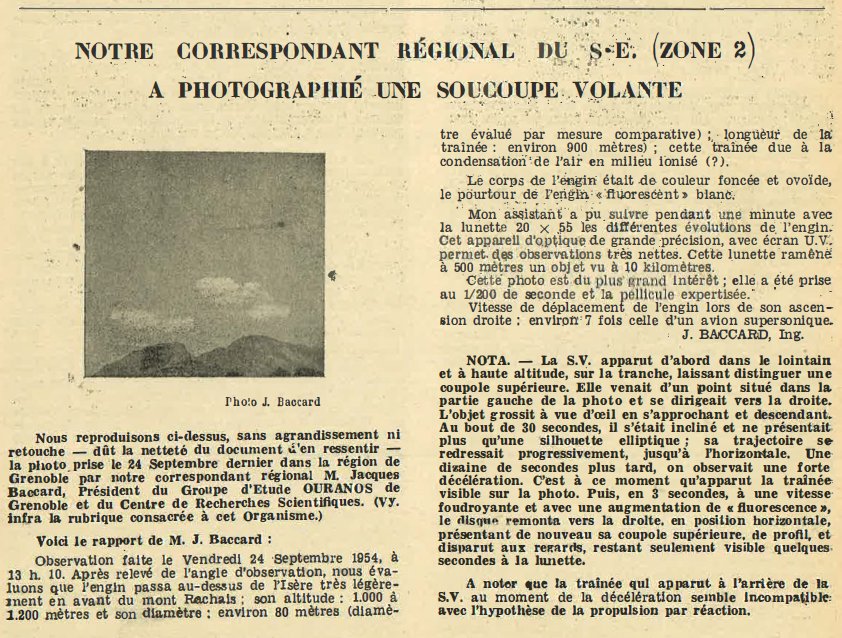
|
Nous reproduisons ci-dessus, sans agrandissement ni retouche - dût la netteté du docmnent s'en ressentir - la photo prise le 24 septembre dernier dans la région de Grenoble par notre correspondant régional M. Jacques Baccard, Président du Groupe d'Etude OURANOS de Grenoble et du Centre de Recherches Scientifiques. (Vy. infra. la rubrique consacrée à cet Organisme.)
Voici le rapport de M. J. Baccard:
Observation faite le Vendredi 24 Septembre 1954, à 13 h. 10. Après relevé de l'angle d'observation, nous évaluons que l'engin passa au-dessus de l'Isère très légèrement en avant du mont Rachais; son altitude: 1.000 à 2000 mètres et son diamètre: environ 80 mètres (diamètre évalué par mesure comparative); longueur de la traînée: environ 900 mètres); cette traînée due à la condensation de l'air en milieu ionisé (?).
Le corps de l'engin était de couleur foncée et ovoïde, le pourtour de l'engin "fluorescent" blanc.
Mon assistant a pu suivre pendant une minute avec la lunette 20 x 55 les différentes évolutions de l'engin. Cet appareil d'optique de grande précision, avec écran U.V. permet des observations très nettes. Cette lunette ramène à 500 mètres un objet vu à 10 kilomètres.
Cette photo est du plus grand intérêt; elle a été prise au 1/200 de seconde et la pellicule expertisée.
Vitesse de déplacement de l'engin lors de son ascension droite: environ 7 fois celle d'un avion supersonique.
J. BACCARD, Ing.
NOTA. - La S.V. apparut d'abord dans le lointain et à haute altitude, sur la tranche, laissant distinguer une coupole supérieure. Elle venait d'un point situé dans la partie gauche de la photo et se dirigeait vers la droite. L'objet grossit à vue d'oeil en s'approchant et descendant. Au bout de 30 secondes, il s'était incliné et ne présentait plus qu'une silhouette elliptique; sa trajectoire se redressait progressivement, jusqu'à l'horizontale. Une dizaine de secondes plus tard, on observait une forte décélération. C'est à ce moment qu'apparut la trainée visible sur la photo. Puis, en 3 secondes, à une vitesse foudroyante et avec une augmentation de "fluorescence", le disque remonta vers la droite, en position horizontale, présentant de nouveau sa coupole supérieure, de profil, et disparut aux regards, restant seulement visible quelques secondes à la lunette.
A noter que la traînée qui apparut à l'arrière de 1a S.V. au moment de la décélération semble incompatible avec l'hypothèse de la propulsion par réaction.
[Ref. ous2:] "OURANOS" UFOLOGY MAGAZINE:
In this ufology magazine of the 4th quarter of 1954, there is a bibliography of articles on recent flying saucers, including:
Radar, October 31: Testomony of Mr. Jacques Baccard, member of the Comité d'Etude and regional correspondent of the C.I.E. OURANOS, president of the Centre de Recherches Scientifiques. Observation de Déret. - Divers.
[Ref. nfe1:] "NORD FRANCE" MAGAZINE:
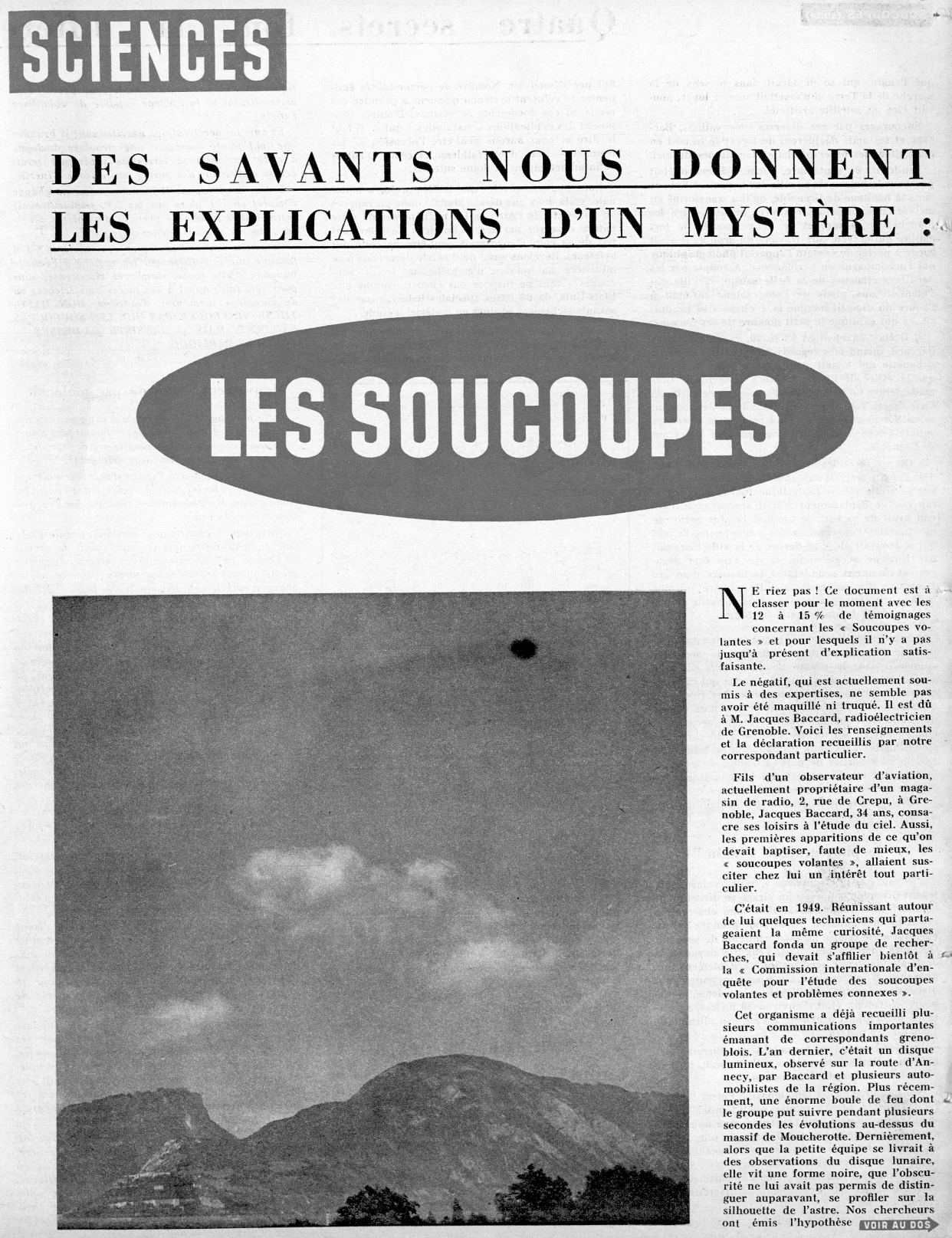
|
Don't laugh! This document is to be classified for the moment with the 12 to 15% of testimonies concerning the "Flying saucers" for which there are so far no satisfactory explanations.
The negative, which is currently being examined, does not appear to have been made up or rigged. It is due to Mr. Jacques Baccard, radioelectrician from Grenoble. Here is the information and the statement collected by our private correspondent.
Son of an aviation observer, currently owner of a radio shop at 2, rue de Crepu, in Grenoble, Jacques Baccard, 34, devotes his spare time to studying the sky. Also, the first appearances of what we should baptize, for lack of anything better, the "flying saucers", aroused in him a very particular interest.
It was in 1949. Gathering around him some technicians who shared the same curiosity, Jacques Baccard founded a research group, which was soon to be affiliated with the "International Commission of Inquiry for the Study of Flying Saucers and related issues."
This organization has already collected several important communications from correspondents in Grenoble. Last year, it was a luminous disc, observed on the road to Annecy, by Baccard and several motorists in the region. More recently, the group was able to follow the moves of a huge fireball over the Moucherotte mount for several seconds. Lately, while the small team was engaged in observations of the lunar disc, they saw a black shape, which the darkness had not allowed her to distinguish before, looming over the silhouette of the star. Our researchers hypothesized
SEE AT THE BACK

|
that the craft, which was moving in the direction of the earth's path and emitted no glow, could be an artificial satellite.
Encouraged by these various observations, Baccard and his friends decided to force chance by increasing the systematic observations of the sky.
Friday, September 24, Jacques Baccard was posted on the balcony of his house on the road to Eybens in the suburbs of Grenoble; which he transformed into a real little observatory. Installed between the measuring boards and the glasses of strong caliber which are used for the work of the group, he had kept within reach the camera which accompanies him at all times. Dozing off by the last heat of the beautiful season, the city which stretched out at the foot of the observer was at drinking time when the "thing" happened, which explains the small number of its witnesses.
"It was exactly 1:10 p.m., says Jacques Baccard, when my eyes were drawn to a silhouette that had just appeared in the gap that the Isère valley makes at the exit of Grenoble, between the Vercors mounds and La Chartreuse. First of all, I took it for an airplane. This passage is indeed the one used by airplanes coming from the north to approach the Grenoble airfield.
"15 seconds had barely elapsed when the craft had already arrived on the outskirts of Grenoble. Intrigued by this fantastic speed, as well as by the fact that this movement was not accompanied by any engine noise, I grabbed the smallest of my spotting scopes. At the same time, the craft which was then above the city marked an abrupt acceleration, followed by a strong luminous emission similar to the light of an electric arc. In addition, it left behind a light gray trail, darker in its axial part, and slightly luminous at the edges.
"Having called my mother and my wife next to me, I had the craft for ten seconds in the field of my telescope (the magnification of which is twenty). Its shape, which appeared to me in perspective as that of a spindle - or a cigar - was in reality those of a disc becoming slightly ovoid towards the rear and comprising in its center a sort of spherical cabin, the two hemispheres of which were equally distributed on both sides on the other side of the plane of the disc. Around it, a bright halo of high intensity which its contours sharp. The body of the craft was of a very dark gray.
"I photograph the machine"
"Seeing that the "saucer ", which was now flying over Grenoble, started a turn towards the Chartreuse, I then abandoned my observation and grabbed my camera to take this shot, which was taken at 5/100s. A few moments later, the craft rose vertically, in a truly lightning acceleration. It took about six to seven seconds to disappear from sight. By my calculations, the diameter of the craft was about eighty meters, its distance from me of 2 kms, its altitude of 1,000 to 1,200 meters."
Jacques Baccard is categorical: it could not have been a weather balloon, nor a flight of birds, nor a known atmospheric phenomenon.
What to think of such a testimony? Of all the stories that the press publishes daily, there appear to be some that present the appearance of seriousness and good faith. In fact, most of the most interesting statements do not see the light of day; they are sent to scientific organizations or to journals like ours by correspondents who ask for discretion for fear of ridicule.
Scientific circles have long been moved by it. Many eminent personalities systematically refuse to take such stories or documents seriously. Others offer "natural" explanations which - it must be said and we will perhaps have the opportunity to summarize them - are extremely weak. Finally, others admit that a doubt remains.
[Ref. hws1:] HAROLD T. WILKINS:
The author reproduces the picture, indicating that it was unretouched, and taken near Grenoble on September 24, 1954.
[Ref. ous3:] "OURANOS" UFOLOGY MAGAZINE:
In this ufology magazine of the 1st quarter of 1955, there is a bibliography of articles on recent flying saucers, including:
Semaine du Monde (Paris), Nov. 5: The saucers (observation of Mr. Jacques Baccard, president of the Centre des Recherches Scientifiques and the Groupe régional d'étude OURANOS, of Grenoble; with photo of Sept. 24. - Article by Lt Plantier).
[Ref. hws2:] HAROLD T. WILKINS:
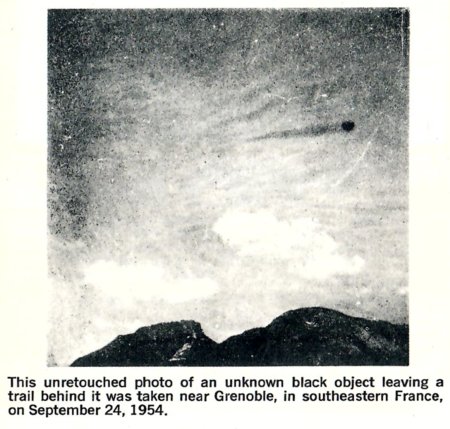
|
This unretouched photo of an unknown black object leaving a trail behinf it was taken near Grenoble, in southeastern France, on September 24, 1954.
[Ref. jgu1:] JIMMY GUIEU:
Jimmy Guieu reports that on September 24, 1954, one of the investigators of his own UFO research group finally managed not only observe but also to photograph a flying saucer above Grenoble.
The photographer was Mr. Jacques Baccard, engineer and specialist in electronics, director of the Grenoble Ouranos Study Group and its Scientific Research center whom had developed the first magnetic detector especially designed for "the automatic detection of the flying saucers."
Jimmy Guieu reproduces the report by Mr. Baccard:
It was exactly 13h10, when my glances were attracted by a silhouette which had just appeared in perforated that the valley of Isère digs at the exit of Grenoble, between the solid mass of Vercors [mountains] and that of Chartreuse. First of all, I mistook the thing for a plane. This passage is indeed that which the airplane use when coming from the North to approach the airfield in Grenoble.
Fifteen seconds had hardly passed that already the machine arrived at the accesses of Grenoble. Intrigued by this fantastic speed, just as by the fact that this displacement was accompanied by no engine noise, I directed the smallest of my of observation binoculars at it. At the same time, the machine which was then above the city marked an abrupt acceleration followed by a strong luminous release of light similar to an electric flash. Moreover, it left a clear, darker gray trail in its axis, and slightly luminous part on the edges, behind it.
Having called my mother and my wife near me, I held the apparatus in the field of my binoculars (enlargement x20) during ten seconds. Its shape, which appeared to me in perspective like that for a spindle or of a cigar was actually that of a disc becoming slightly ovoid at its back and comprising in its miffle a kind of spherical fuselage whose two hemispheres were evenly distributed on both sides of the disc's plane. Around this part in the middle, a luminous halation of strong intensity made the contours blurred from there. The body of the machine was of a very dark metal gray and its periphery of a fluorescent white.
Seeing that the flying saucer which now flew above Grenoble started a turn in the direction of La Chartreuse, I gave up my observation then and seized my camera to take a snapshot which was carried out with 200th of a second exposure. A few moments later, the machine rose vertically, in a striking down acceleration. It took approximately 6 to 7 seconds to disappear from our sight. According to my calculations, the diameter of the machine was approximately 80 meters (evaluated by comparative measurement); I evaluated its distance as of 2 kilometers; its altitude from 1.000 to 1.200 meters. Length of the contrail: approximately 900 meters (contrail probably due to the condensation of the air in ionized medium). Speed of the machine during its vertical rise: 7 times that of a supersonic plane.
It should be noted that it is precisely at the time of its strong deceleration that the long trail appeared! This fact alone is incompatible with the assumption of a jet propulsion.

|

|
Above: The picture shows Jimmy Guieu on the left and Jacques Baccard on the right, testing "a magnetic detecter reacting to the passage of flying saucers" built by Baccard.
[Ref. gqy1:] GUY QUINCY:

|
September 24 [1954]
01:10 p.m.: Grenoble (Isère):disc moving at 900 m. alt.photog.Baccard
[Ref. aml3] AIME MICHEL:
Writing about the alignment of observations Bayonne-Vichy for September 24, 1954, he thought he discovered, Aimé Michel noted:
I had, at the end of my investigation in 1957, found nine points in all. Searching for years, Jacques Vallée found five others.
It turns out that on five additional observations one (Sierra de Gardunha, Portugal) is situated on Bavic, which thus becomes a seven-point alignment of enormous improbability, and that the other four (Vierzon, Clermont-Ferrand, Besançon and Grenoble) form two new alignments.
[Ref. jde1:] J. BERNARD DELAIRE:

|
0092; 1954: September 24th Time: unnoted.
Near Grenoble, FRANCE.
A black sphere trailing smoke. (photographer unnamed).
Refs: Wilkins, 1956, pl. opp.p.65.
[Ref. gep1:] UFOLOGY GROUP "GEPO":
| 09 24 54 (13) | Grenoble (isère) | H 03 M T | 104C2 | Y |
[Ref. mju1:] MICHEL JEANTHEAU:
While browsing his documentation to check the cases allotted to the September 24 of 1954 that presumedly formed an line with Bayonne and Vichy as reference points, Michel Jeantheau checks on a case that Jacques Vallée indicated as of September 24, 1954 in Grenoble.
He finds out about the case in the newspaper Le Parisien Libéré, for September 30, 1954. The photographs sees hom skeptical since it does not fit the visual description.
He notes further that Mr. Baccard was alone with only two family members in the center of a town.
[Ref. jdn1:] JEAN-PHILIPPE DAIN:
Ref. UFOTO: 0503
24 SEP 1954
Location: Grenoble (FRA) / Author: BACCARD Jacques
[Ref. goe1:] GODELIEVE VAN OVERMEIRE:
The Belgian ufologist indicates that in 1954, on September 24 in France, in the area of Grenoble "At 13:10 Jacques Baccard succeeds in photographing a UFO."
The source is indicated as "Jimmy GUIEU: 'Black-out sur les S.V.' - Fleuve Noir 1956 - p. 146".
[Ref. lhh1:] LARRY HATCH - "*U* COMPUTER DATABASE":
3830: 1954/09/24 00:00 1 5:44:00 E 45:15:00 N 3331 WEU FRN ISR 6:6
nr GRENOBLE,FR:FOTO=BLK SCR or ORB:LVS DRK TRAIL BEHIND:see foto section:NFD
Ref#107 WILKINS,Harold: F.S. UNCENSORED Page No. 136: MOUNTAINS
[Ref. lcn1:] LUC CHASTAN:
Luc Chastan indicates that in the Isère in Grenoble on September 24, 1954 at 13:10 hours "It was exactly 13:10, when my glances were attracted by a silhouette which had just appeared in the opening of the valley of the Isère at the exit of Grenoble, between Mount Vercors and that of Chartreuse. Initially, I took the thing for a plane. This passage is indeed the one planes coming from the North use to approach the Grenoble field."
"Fifteen seconds had hardly passed when the craft already arrived at the accesses of Grenoble. Intrigued by this fantastic speed, as well as by the fact that this displacement was accompanied by no engine noise, I pointed the smallest of my observation glasses. At the same time, the craft which was then above the city marked a sudden acceleration followed by a strong luminous release similar to the light of an electric arc. Moreover, it left behind a clear, darker gray trail in its axial, and slightly luminous part on the edges."
"Having called my mother and my wife near me, I held during ten seconds the craft in the field of my glasses (power 20). Its shape, which appeared to me in perspective like that for a spindle or of a cigar was actually that of a disc becoming slightly ovoid backwards and comprising in its middle a kind of fuselage spherical whose two hemispheres were also distributed on both sides of the disc's plan. Around this one, a luminous halation of strong intensity produced vague contours. The body of the craft was of a very dark metal gray and its periphery of a fluorescent white."
"Seeing that the flying saucer which flew over Grenoble now started a turn in direction of Chartreuse, I gave up my observation then and grabbed my camera to take a photograph which was done at the 200th of a second. A few moments later, the machine rose vertically, in a tremendous acceleration. It put approximately 6 to 7 seconds to disappear from our sight. According to my calculations, the diameter of the machine was approximately 80 meters (evaluated by comparative measurement); its distance to me was 2 kilometers; its altitude from 1.000 to 1.200 meters. Length of the trail: approximately 900 meters. Speed of the machine during its vertical rise: 7 times that of a supersonic plane."
"It should be noted that it is precisely at the time of its strong deceleration that the long trail appeared!"
"It should be noted that if this observation is so precise it is because the witness is a ufologist. It is Jacques Baccard, member of the C.I.E.O. and friend of Jimmy Guieu."
Luc Chastan note comme sources "Les OVNI vus de près by Gross Patrick ** http://ufologie.net" and "Black-out sur les Soucoupes volantes by Guieu Jimmy ** Fleuve Noir 1956 omnium 1977".
He published as small-size image of the photograph.
[Ref. jbs1:] VICENTE-JUAN BALLESTER-OLMOS, "FOTOCAT 1954":
(50)
DATE: 24 September 1954
LOCATION: Grenoble (France)
FORMAT: Picture
PHOTOGRAPHER: Jacques Baccard
EXPLANATION: Not available
REFERENCES: Harold T. Wilkins, Flying Saucers Uncensored (Citadel, 1955), plate. Jimmy Guieu, Black out sur les soucoupes volantes (Editions Fleuve Noir, 1956), pages 128-130 and plate 12. Gianfranco de Turris and Sebastiano Fusco, Obiettivo sugli UFO. Fotostoria dei Dischi Volanti (Edizioni Mediterranee, Rome, 1975), page 115.
See the gallery of UFO photos by Stéphane Bernard:
http://moumra.onzenet.com/moumraV12/soucoup/ddnbdate/19540924ddnbfr5364.jpg
REMARKS: Nil
[Ref. uda1:] "UFODNA" WEBSITE:
The website indicates that on 24 September 1954 at 13:10 in Grenoble, France "Photo of black disc or sphere. Left dark trail of smoke behind." And: "An object was observed and photographed. One black sphere was observed by one witness at a mountain for 30 seconds (Baccard)."
The sources are indicated as Guieu, Jimmy, Flying Saucers Come from Another World, Citadel, New York, 1956; Vallee, Jacques, Computerized Catalog (N = 3073); Delaire, J. Bernard, UFO Register Volume 6 (1975), Data Research, Oxford, 1975; Hatch, Larry, *U* computer database, Author, Redwood City, 2002.
[Ref. ubk1:] "UFO-DATENBANK":
This database recorded this case 4 times:
| Case Nr. | New case Nr. | Investigator | Date of observation | Zip | Place of observation | Country of observation | Hour of observation | Classification | Comments | Identification |
|---|---|---|---|---|---|---|---|---|---|---|
| 19540924 | 24.09.1954 | Grenoble | France | CE I | ||||||
| 19540924 | 24.09.1954 | Grenoble Mt. Rachais | France | |||||||
| 19540924 | 24.09.1954 | Grenoble | France | |||||||
| 19540924 | 24.09.1954 | Grenoble | France |
[Ref. bo2:] VICENTE-JUAN BALLESTER-OLMOS, "FOTOCAT 1954":
(57)
Date: 24 September 1954
Time: 13:10
Location: Grenoble, Isère (France)
Format: Picture
Photographer: Jacques Baccard
Explanation: Not available
References: Ouranos, 12, 4th Quarter 1954, page 10. Harold T. Wilkins, Flying Saucers Uncensored (Citadel, New York, 1955), plate. Jimmy Guieu, Black out sur les soucoupes volantes (Editions Fleuve Noir, 1956), pages 128-130 and plate 12. Gianfranco de Turris and Sebastiano Fusco, Obiettivo sugli UFO. Fotostoria dei Dischi Volanti (Edizioni Mediterranee, Rome, 1975), page 115. Patrick Gross, http://ufologie.net/1954/24sep1954grenoblef.htm [old URL of this page].
REMARKS: Nil
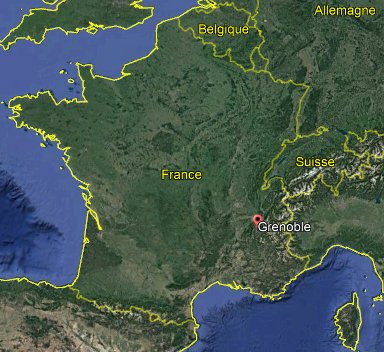
|
Probable fake. The flying saucer looks like an ink stain wiped into a trace when it was almost dry.
It is clear that the thing on the photograph and its trail are dark, showing no "fluorescence" or light; which does not match the visual description.
(These keywords are only to help queries and are not implying anything.)
Grenoble, Isère, Jacques Baccard, Ouranos, disc, gray, metallic, trail, contrail, blurred, dome, round, photograph, turn, fast, elevation, duration, binoculars, fluorescent, white
[----] indicates sources that are not yet available to me.
| Version: | Created/Changed by: | Date: | Change Description: |
|---|---|---|---|
| 0.1 | Patrick Gross | November 8, 2006 | First published. |
| 1.0 | Patrick Gross | February 10, 2010 | Conversion from HTML to XHTML Strict. First formal version. Additions [goe1], [lcn1], [uda1]. |
| 1.1 | Patrick Gross | February 27, 2017 | Additions [ern1], [ubk1]. |
| 1.2 | Patrick Gross | March 2, 2017 | Addition [ame1]. |
| 1.8 | Patrick Gross | April 20, 2018 | Addition [bo2]. |
| 1.9 | Patrick Gross | January 22, 2019 | Additions [ous1], [ous2], [ous3], [lhh1], [jde1]. |
| 2.0 | Patrick Gross | September 24, 2019 | Additions [aml3], Summary. |
| 2.1 | Patrick Gross | December 30, 2020 | Addition [nfe1]. |
| 2.2 | Patrick Gross | March 15, 2021 | Addition [gqy1]. |
| 2.3 | Patrick Gross | April 6, 2022 | Additions [hws1], [gep1]. |
| 2.4 | Patrick Gross | August 23, 2025 | Addition, [sme1]. |